To navigate safely back to shore, blend traditional techniques with modern technology. Use your compass and charts to establish a clear bearing while visualizing landmarks to triangulate your position. Regularly check local weather and tidal conditions, adjusting your route accordingly. Always have electronic devices like GPS handy, but don't rely on them solely due to possible connectivity issues. Keep essential safety gear onboard and remain alert for any navigational errors. This combination of methods and preparation can make your return much safer. There's more to discover about enhancing your navigation skills to ensure your safety at sea.
Key Takeaways
- Utilize compass navigation skills to maintain a steady bearing towards the shore, adjusting for wind and current as needed.
- Identify and triangulate your position using three visible landmarks for accurate location assessment.
- Regularly check navigational charts and ensure they are updated to avoid hazards and miscalculations.
- Monitor tidal dynamics and local weather conditions to choose the best time for your return trip.
- Keep traditional navigation tools, like charts and compasses, as backups to electronic devices for safety.
Introduction
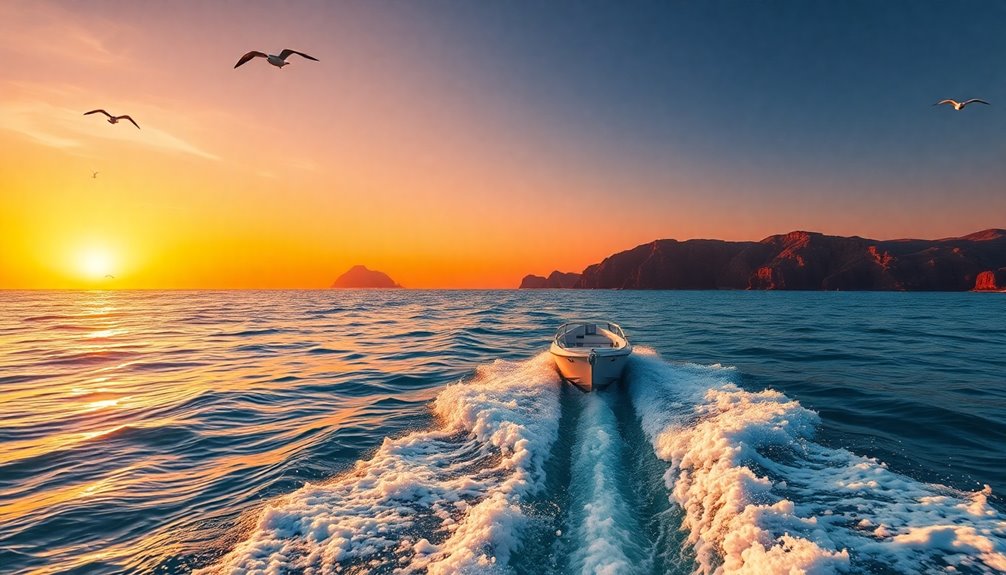
When you're out at sea, knowing how to navigate with a compass is essential for a safe return.
While electronic tools are helpful, traditional skills can save you when technology fails.
Mastering compass navigation ensures you stay on course, especially in unfamiliar waters.
Navigating With Compass Skills
A compass is your trusted ally on the open water, guiding you towards your destination with precision.
When navigating with compass skills, it's crucial to understand how your compass indicates direction relative to magnetic north. By calculating the bearing to your desired destination, you can align your boat's heading effectively.
Use parallel rulers on charts to determine accurate compass bearings, ensuring you reach your waypoints. Remember to triangulate your position by recording the bearings of three identifiable landmarks.
Regular practice is key—build your confidence and proficiency in these techniques, especially in areas with limited electronic support. Following these safety tips will enhance your navigation skills and help you find your way back to shore safely.
Essential for Safe Navigation
Navigating the open water safely hinges on your ability to blend modern technology with traditional skills. Familiarizing yourself with both electronic tools, like GPS and chartplotters, and traditional navigation methods, such as compasses and charts, is crucial for boating safety.
Regularly check your equipment's functionality and maintain your traditional tools to avoid relying on malfunctioning systems when it counts. Understanding tidal dynamics, especially during spring tides that can reach up to 2.3 knots, is vital for timing your passage.
Crafting and managing waypoints based on local navigation challenges and environmental factors enhances your route planning. Lastly, commit to continuous learning about navigation techniques and stay updated with local waterway information to ensure a safe arrival back to shore.
Key Concepts of Navigation
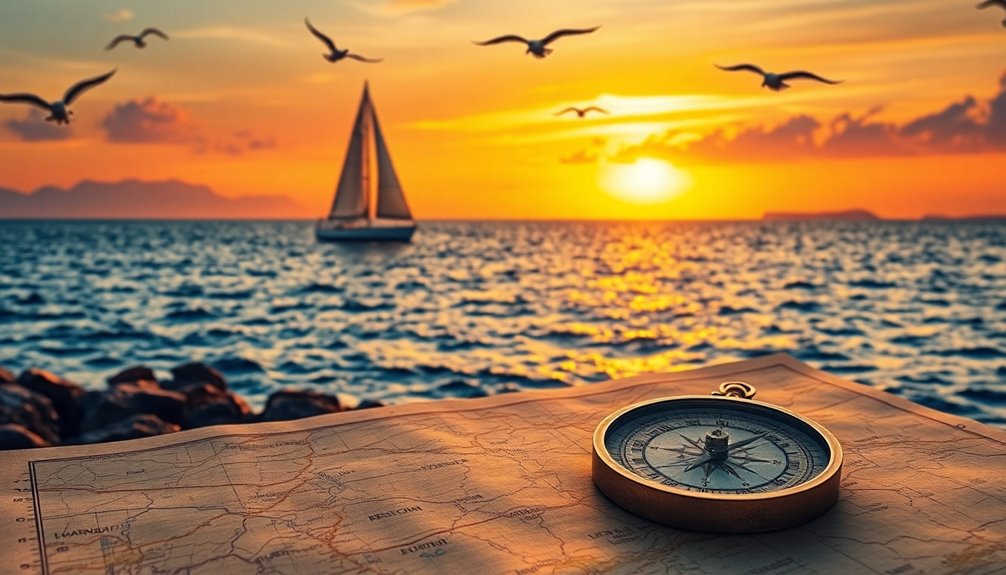
Effective navigation is essential for any mariner, as it ensures a safe journey back to shore.
You can utilize electronic methods like GPS and chartplotters, which provide real-time positioning and allow you to create waypoints for efficient routing. However, don't overlook traditional navigation tools such as compasses, charts, parallel rulers, and dividers.
Understanding nautical miles—defined as 60 minutes per degree, with 1 minute equating to 1 nautical mile—is crucial for accurately gauging distances at sea.
When planning your route, consider local conditions like tides and depths, and strategically place waypoints to avoid hazards.
Familiarizing yourself with both electronic and traditional navigation methods enhances your overall safety and effectiveness as you navigate back to shore.
Navigating in Emergency Situations

When you're faced with an emergency at sea, your first step is to assess the situation and use your navigation tools to pinpoint your location.
Keep an eye on local weather conditions, as they can change rapidly and affect your route back to shore.
Avoiding Maritime Disasters
In emergency situations at sea, staying calm and making quick decisions is crucial to avoiding maritime disasters.
It's absolutely vital to assess your boat's position using three visible landmarks for triangulation, which helps plot a safe course back to shore. Keep a steady compass bearing toward your destination, adjusting as needed for wind and current—small deviations can lead to significant errors.
If your GPS fails, switch to traditional navigation methods: use a compass, charts, and dividers to maintain awareness.
Additionally, regularly check tidal conditions, planning your return during favorable tides. Misjudging tidal streams can cause delays and create hazards, so always stay alert and adapt your strategy as the situation unfolds.
Local Weather Conditions
Local weather conditions can make or break your safe return to shore during an emergency. Conditions at sea change rapidly, so you must regularly monitor weather forecasts to anticipate potential hazards like storms or high winds.
Pay attention to shifting wind patterns, as they'll impact your navigation and ability to maneuver safely toward land. Utilize barometric pressure readings; a falling barometer often signals worsening weather, prompting you to take immediate action.
Be familiar with local tidal patterns and current strengths, as they can significantly affect your navigation speed. Always have a contingency plan ready, including predetermined safe havens or anchorages, in case you need to adjust your course quickly when conditions deteriorate.
Stay alert and prepared to ensure a safe return.
Navigating With Visual Landmarks
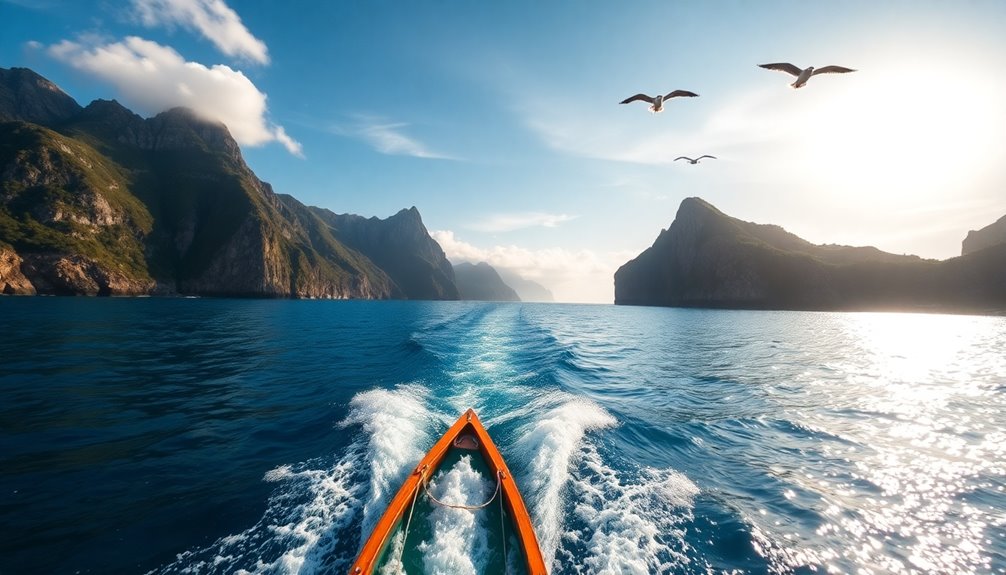
Navigating with visual landmarks can significantly enhance your confidence at sea, as it allows you to connect your immediate surroundings with your navigational charts.
To effectively use this method, make sure you identify three distinct charted features along the coast that are visible from your current position. Use a compass to take bearings of these landmarks, noting their degrees relative to magnetic north for precise course plotting.
Draw intersecting lines from these bearings on your chart; the point where they converge indicates your boat's position. Maintain your course by continuously referencing your compass, ensuring alignment with your calculated bearing toward your destination.
Always verify the accuracy of your charts and familiarize yourself with local landmarks for enhanced navigational safety and efficiency.
Navigation Apps and Devices
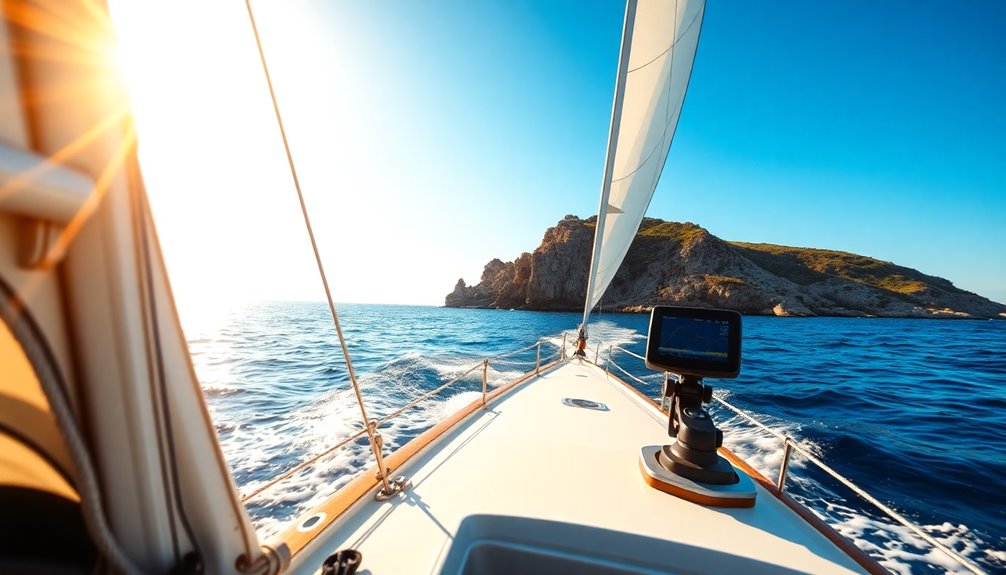
Modern navigation apps and devices revolutionize the way you plot your course at sea. These apps on your smartphone provide real-time GPS positioning and mapping, enhancing your navigation experience.
However, don't rely solely on them, as connectivity issues and environmental risks may arise. Consider using dedicated navigation devices, like chartplotters, which allow you to easily create and manage waypoints for safer route planning.
Many navigation apps also offer vital features like tidal information and weather updates to help you avoid adverse conditions. Remember to regularly check for software updates and ensure your charts are current.
Lastly, always keep traditional charts and compasses on board as backup navigation methods in case of electronic device failure.
Safety Gear Recommendations
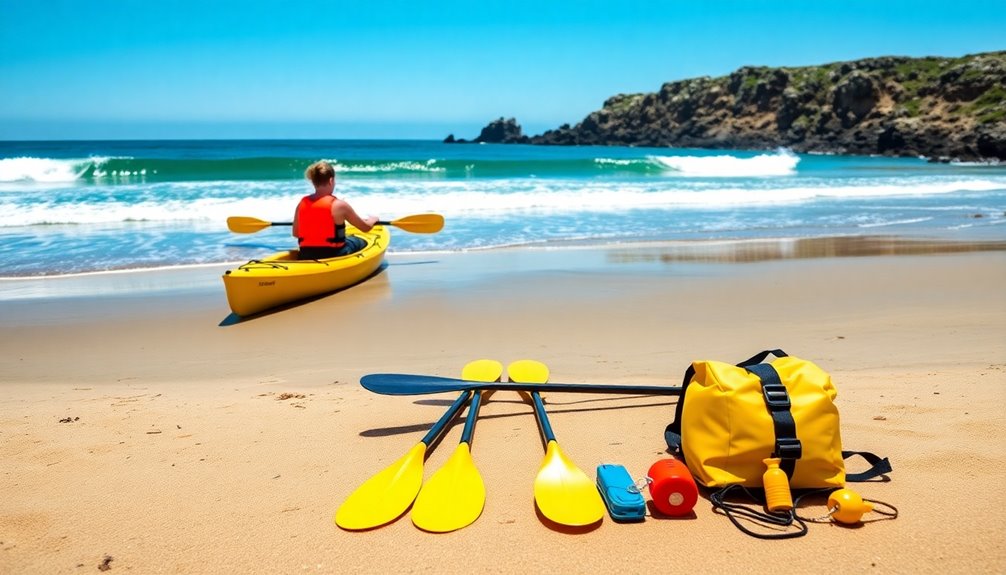
When heading out to sea, having the right safety gear can make all the difference in an emergency. Always wear a properly fitted life jacket approved by a recognized safety authority; it significantly boosts your survival chances in the water.
Equip your boat with a Personal Locator Beacon (PLB) or an EPIRB to send distress signals and pinpoint your location for rescue services. Don't forget a fire extinguisher that meets local regulations, ensuring it's easily accessible.
A well-stocked first aid kit with essentials like bandages and seasickness medication is crucial for addressing injuries.
Lastly, keep signaling devices like flares or a whistle on board to attract attention, especially when you're in sight of land and need immediate help.
Navigational Errors and Corrections

Navigational errors can trip you up, but using sonar technology can give you a clearer picture of your surroundings.
It's crucial to regularly update your navigational charts to reflect any changes in the area. By staying proactive, you can correct mistakes before they lead you too far off course.
Use of Sonar Technology
As you navigate through unfamiliar waters, sonar technology becomes an invaluable tool in detecting submerged hazards and mapping the seafloor. It utilizes sound waves to identify underwater objects and measure the distance to them, providing crucial information that enhances your navigation safety.
In shallow waters, sonar helps you spot depth changes and potential obstacles that traditional charts might miss, allowing for real-time course adjustments. However, be cautious; errors in navigation can occur from misinterpreting sonar data. Always cross-reference sonar readings with visual observations and electronic charts.
Regularly calibrating and maintaining your sonar equipment is essential, as environmental factors can affect sound wave propagation. Ultimately, sonar empowers you to correct navigational errors and adjust your position accurately.
Regularly Update Navigational Charts
Accuracy is vital for safe navigation, and regularly updating your navigational charts is crucial. Outdated charts can lead to dangerous navigational errors and miscalculations, putting your safety at risk.
Make sure to source electronic charts from reputable providers like Navionics and C-MAP, updating them frequently to reflect current conditions. This practice allows for precise distance calculations in nautical miles, essential for effective passage planning.
Additionally, being aware of local navigation challenges, such as changes in water depths and hazards, necessitates these updates to avoid potential obstacles.
Pairing updated charts with a tidal atlas will further enhance your navigation safety by providing accurate tide timings and strengths, ensuring you're well-prepared for your journey back to shore.
Coastal Rescue Operations
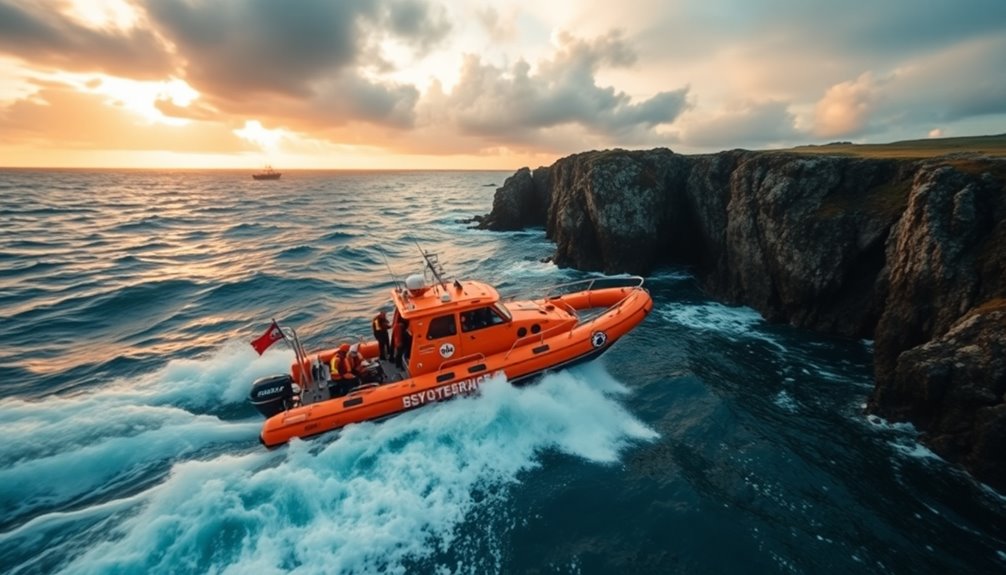
In recent years, coastal rescue operations have become increasingly vital as more people engage in water activities. These operations rely on effective coordination between maritime authorities, local rescue teams, and volunteer organizations.
When emergencies arise, rescuers utilize various vessels, such as rescue boats, helicopters, and drones, adapting to the situation and environmental conditions. Accurate navigation and communication systems play a crucial role in locating individuals in distress quickly, ensuring timely help.
Training for rescue personnel emphasizes understanding tidal patterns, weather conditions, and navigation techniques, enhancing safety and efficiency. Regular drills and simulations prepare teams for real-life scenarios, like capsized boats or stranded individuals.
Conclusion
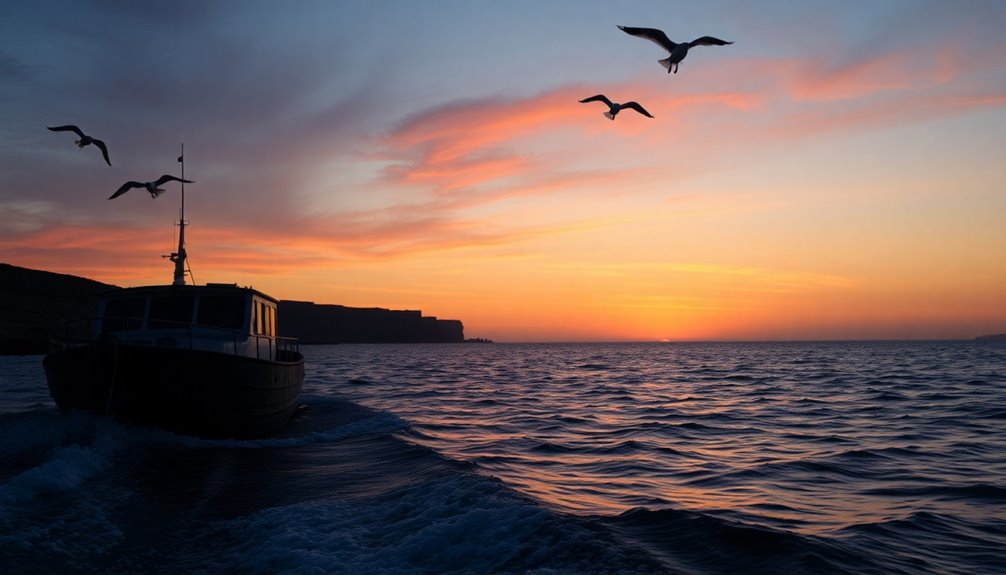
Navigating back to shore safely hinges on mastering both electronic and traditional navigation methods.
To ensure success, you need to create a route that incorporates waypoints based on latitude and longitude, providing a clear path to your destination. Understanding tidal dynamics and local currents is essential, as they can impact your timing and safety as you approach the shore.
Familiarity with navigational charts and local geography will aid your decision-making, particularly in waters with potential hazards. Continuous learning and practice improve your navigation skills, whether you're using chart plotters or traditional tools.
Additional Resources
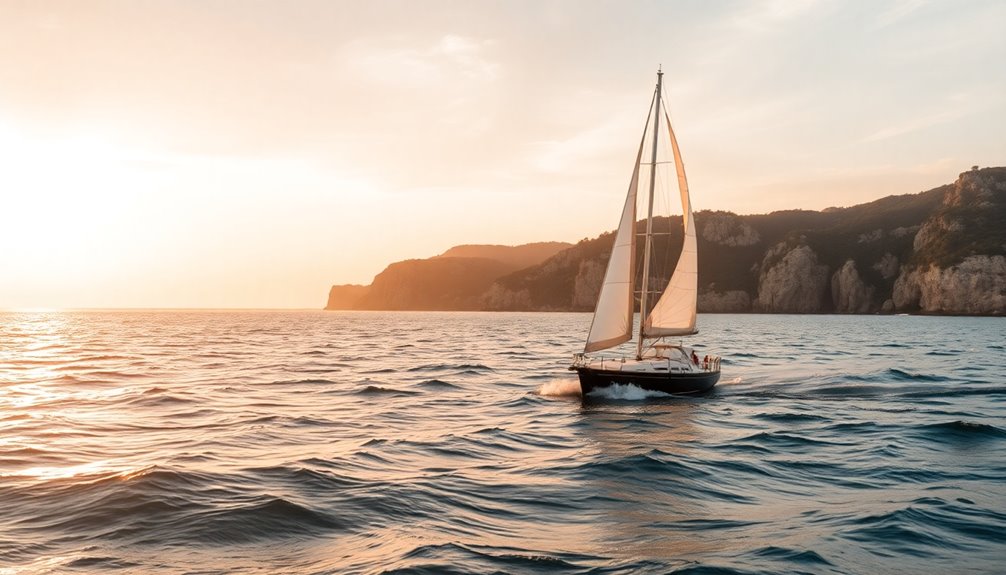
When it comes to enhancing your navigation skills, several resources can make a significant difference. Familiarize yourself with essential navigation books, like those by Mary Blitt and updated guides such as "Easy Navigation for Beginners."
These additional resources will improve your understanding of both traditional and electronic navigation methods. Explore digital sailing resources at gentlessailing.com for insights on Mediterranean routes and Atlantic crossings.
Utilize electronic chart plotters to accurately plot your course line and transfer waypoints from laptops via memory cards or Bluetooth. Continuous learning is key—consider popular titles like "Your Boat in the Sun" and "Atlantic Crossing Guide" to stay updated on best practices.
Engaging with these resources will ensure you navigate back to shore safely and confidently.
Frequently Asked Questions
How to Navigate Through the Ocean?
To navigate through the ocean effectively, you need to use electronic navigation tools like GPS and chartplotters, which help you determine your position and create waypoints.
Familiarize yourself with traditional methods, such as using a compass and nautical charts to identify landmarks. Always check your devices' functionality and keep backups handy.
Plan your route carefully, considering hazards and tidal dynamics, and aim to arrive at your destination well before sunset for better visibility.
How to Use a Compass at Sea?
To use a compass at sea, hold it level and point the direction of travel arrow towards your destination.
Read the bearing in degrees, remembering to adjust for magnetic declination according to your location.
Use parallel rulers to transfer these bearings to your chart, plotting your course visually.
Regularly check your compass for accuracy and ensure it's calibrated, as nearby metal objects or electronics can affect its readings.
Stay aware and navigate confidently!
How to Navigate the Intracoastal?
To navigate the Intracoastal Waterway (ICW), you'll want to combine electronic tools like GPS and chartplotters with traditional charts.
Familiarize yourself with the area's depth and tidal information, as these can change quickly. Keep an eye on navigational aids like buoys and markers to avoid hazards.
Regularly consult nautical charts and stay aware of local currents. Always prepare for weather changes, having contingency plans to ensure a safe journey along the ICW.
What Is Ocean Navigation Called?
Ocean navigation is commonly referred to as maritime navigation.
It's the process you use to guide your vessel over open water, combining both modern electronic systems like GPS and traditional methods such as celestial navigation.
You'll need to understand nautical charts, buoy systems, and tidal dynamics to ensure a safe journey.










